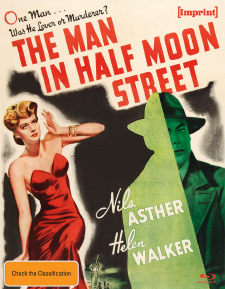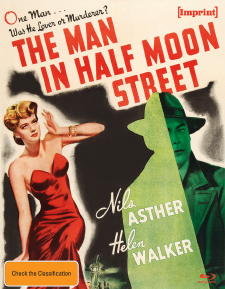Man in Half Moon Street, The (Blu-ray Review)

Director
Ralph MurphyRelease Date(s)
1945 (November 29, 2023)Studio(s)
Paramount Pictures (Imprint/Via Vision)- Film/Program Grade: B
- Video Grade: A-
- Audio Grade: A
- Extras Grade: B
Review
Eternal youth has served as the basis for many films through the years, among them Lost Horizon, The Wasp Woman and, perhaps most famously, The Picture of Dorian Gray. An almost forgotten film, the World War II-era The Man in Half Moon Street tackles the subject through a blend of science fiction and film noir.
Dr. Julian Karell (Nils Asther, Night Monster), a British scientist, is engaged to Eve Brandon (Helen Walker, Nightmare Alley), the daughter of an influential English lord. Eve knows that Julian is working on some secret experiments but has no idea that he and his German colleague Dr. Kurt Van Bruecken (Reinhold Schunsel, Notorious) are engaged in proving that they have devised a way to prolong human life indefinitely. By receiving transplants of glands from a younger human every ten years, an aging human can look and feel youthful and vigorous again. As long as the transplants take place on schedule, in theory a person could live forever.
The only way to verify that their method would work was to perform the transplants on a human being. Julian volunteered himself and Van Bruecken did the surgeries. Now, though he looks 30, Julian Karell is actually 120 years old. In addition to not knowing any of this, Eve is also unaware that these experiments require the deaths of the younger men.
Eventually, Eve’s father Sir Humphrey Brandon (Edmund Breon, Gaslight) and her former suitor Dr. Henry Latimer (Paul Cavanagh, The Four Skulls of Jonathan Drake) begin to suspect that Karell’s experiments have a dark side. Together, they prevail upon Scotland Yard’s Detective Inspector Ned Garth (Matthew Boulton, Ministry of Fear) to investigate, and Karell’s backstory comes into question.
Asther and Walker are nearly forgotten nowadays, but they do a solid job of grounding the fantastic story. As Karell, Asther conveys an urbane polish in social situations and a debonair arrogance when speaking with the inspector. With Eve, he’s all charm and devotion, and we believe he’s sincere. As Eve, Walker conveys intelligence and warmth but also a steely side when she defends Karell against the suspicions of Latimer and the inspector. She accepts Karell’s secretiveness, believing that he’s on the verge of some amazing discovery. Her love for him blinds her to the very idea that his secrecy could possibly conceal a deadly truth.
Schunsel’s Dr. Van Bruecken represents age and the wisdom it brings. He tries to become Karell’s conscience when he meets Eve. He believes it’s unfair for Karell to wed her despite knowing that she will have to watch herself age as her husband retains his youth. Van Bruecken is a Van Helsing type of character—old and physically frail, scientifically adventurous and spiritually moral. “No man can break the law of God,” he cautions.
Director Murphy has directed this dialogue-heavy picture with subtlety and an emphasis on effectively developing each major character. He films scenes traditionally, with establishing shots moving in to medium compositions. He’s not especially imaginative in his staging, either, settling for basic shots rather than using clever angles, interesting lighting, and a moving camera to provide visual variety. The script informs us early of Karell’s nefarious secrets, so while other characters take a while to figure out his unorthodox methods, we already know, and the potential for suspense is seriously impaired.
Though their roles are talky, the actors are convincing enough that we remain interested as their characters discuss the moral and ethical responsibilities of science. But the two leads lack the star power to raise this film above mere programmer. A more charismatic pair than Asther and Walker would have lent the picture more luster. Asther is stiff and awkward in the early scenes, when his Karell has romantic encounters with Walker. She similarly sparks little chemistry with him and seems more stubborn than loyal in rejecting well-grounded warnings against her fiancé.
Made by Paramount, The Man in Half Moon Street has no monsters, which rival studio Universal specialized in at the same time. It concentrates instead on characters more than graphic chills and make-up effects. Only one scene required aging effects, accomplished with special make-up applied to Asther’s face along with lighting changes—the same technique that transformed Fredric March into his horrid alter-ego in Dr. Jekyll and Mr. Hyde.
The Man in Half Moon Street has been difficult to see for years. It would show up on late-night TV in the 1960s and 1970s but has been hard to find in recent years. The release by Imprint is the first time it has appeared on home video. Based on a British stage drama by Barre Lyndon, the screenplay by Charles Kenyon and Garrett Fort eliminates some of the play’s more gruesome parts. The only action sequence occurs when Karell rescues a despondent medical student (Morton Lowry) from a suicide attempt. Basil Rathbone and Albert Dekker were originally considered for the role of Karell before Asther was announced as the picture’s star. Susan Hayward was also rumored to be cast, but contract player Walker got the part. When originally released, The Man in Half Moon Street played as the second feature on a double bill with Fritz Lang’s Ministry of Fear. The film was remade in 1959 as The Man Who Could Cheat Death.
The Man in Half Moon Street was shot by director of photography Henry Sharp on 35 mm black & white film with spherical lenses and presented in the aspect ratio of 1.37:1. The Blu-ray print is sourced from a new 2K scan. Picture quality is very good with the exception of reel changeover cue marks in the upper right hand corner of the screen. Other restorations seem to have had no trouble removing these. There are no other visual imperfections. Blacks are deep and rich. Details are well delineated in Helen Walker’s dresses, scientific equipment in Karell’s lab, handwritten experiment notes, and an elaborate garden set with an abundance of flowers and shrubbery. A scene near the river is laden with fog and very atmospheric as Karell stalks the medical student bent on suicide.
The soundtrack is English 2.0 Mono LPCM. Optional English subtitles are available. Dialogue is clear and distinct. Miklos Rozsa’s score is moody and adds a feeling of eeriness. It’s unusual for Rozsa, who usually scored A pictures such as Ben-Hur and Spellbound, to provide music for a B movie.
The Region-Free Blu-ray release from Imprint Films includes the following extra:
- Audio Commentary by Film Historian Tim Lucas
Audio Commentary – The Man in Half Moon Street was first released in Sydney, Australia in November, 1944, well before its opening in the United States. The film may have slipped into obscurity because its stars, Nils Asther and Helen Walker, are “all but forgotten today.” Director Ralph Murphy is even more unknown. The opening, in which three different characters speak about Dr. Karell, hooks the viewer because Karell is referred to as a murderer. Karell is initially portrayed as a romantic hero. Though Universal led in horror film production at the time, Paramount had also entered the field with Island of Lost Souls, Dr. Cyclops, The Cat and the Canary, The Ghost Breakers and The Uninvited. Only their Dr. Jekyll and Mr. Hyde featured a monster, while Universal’s trademark was monsters. The Frankenstein creature, the Mummy, Dracula, the Wolf Man and numerous sequels were box office gold for the studio. The Man in Half Moon Street was the last foray into science fiction by Paramount until When Worlds Collide in 1951. The film draws upon a Sorcerer’s Apprentice-type relationship between Karell and the medical student he rescues. Both are willing to break the law in the name of scientific research and the betterment of mankind. Another example of this can be seen in Revenge of Frankenstein, in which a student successfully accomplishes an operation with skills he had learned from his mentor. Helen Walker was “a cut above” other B movie actresses of the period; she provides a wealth of subtext to her line readings, and her Eve looks to Van Bruecken as her fiancé’s mentor but is kept in the dark about the true nature of Karell’s experiments. Walker was in a bad automobile accident in 1947 and was charged with manslaughter when one of the passengers in the car she was driving was killed. Her career suffered from bad publicity surrounding the accident, her contract at Paramount was not renewed, and her career went into decline. Attention is drawn to an eight-minute scene between Karell and Van Bruecken in Karell’s study that, because of the literate writing, holds the viewer’s attention. Immortality is discussed in the H. Rider Haggard novel She, which was adapted to the screen eleven times, four times during the silent era.
The Man in Half Moon Street is a drama based on a fantastic premise. The screenplay provides a logical explanation of how Karell has managed to live so long, grounding the tale in the realm of the believable. Lacking monsters, supernatural mumbo-jumbo, superstition or overt horror, the film keeps the viewer hooked as the odd tale plays out. Stronger leads could easily have elevated this movie to a major entry in the fantasy/sci-fi genre. Though it’s not a classic, it’s well worth seeing, especially in this welcome new release.
- Dennis Seuling

